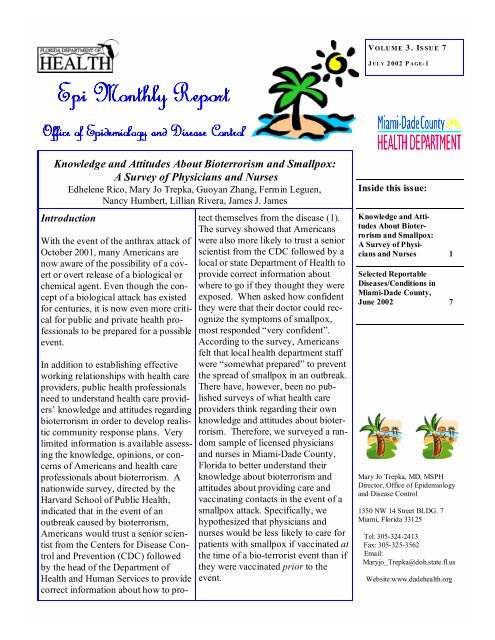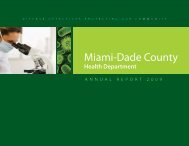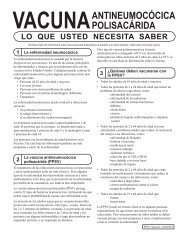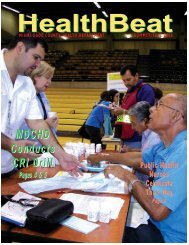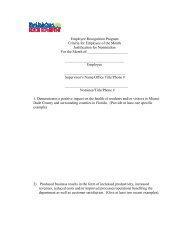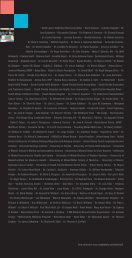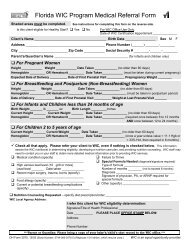Knowledge and Attitudes About Bioterrorism and Smallpox: A ...
Knowledge and Attitudes About Bioterrorism and Smallpox: A ...
Knowledge and Attitudes About Bioterrorism and Smallpox: A ...
You also want an ePaper? Increase the reach of your titles
YUMPU automatically turns print PDFs into web optimized ePapers that Google loves.
VOLUME 3. ISSUE 7<br />
J UL Y 2002 PAGE-1<br />
<strong>Knowledge</strong> <strong>and</strong> <strong>Attitudes</strong> <strong>About</strong> <strong>Bioterrorism</strong> <strong>and</strong> <strong>Smallpox</strong>:<br />
A Survey of Physicians <strong>and</strong> Nurses<br />
Edhelene Rico, Mary Jo Trepka, Guoyan Zhang, Fermin Leguen,<br />
Nancy Humbert, Lillian Rivera, James J. James<br />
Introduction<br />
With the event of the anthrax attack of<br />
October 2001, many Americans are<br />
now aware of the possibility of a covert<br />
or overt release of a biological or<br />
chemical agent. Even though the concept<br />
of a biological attack has existed<br />
for centuries, it is now even more critical<br />
for public <strong>and</strong> private health professionals<br />
to be prepared for a possible<br />
event.<br />
In addition to establishing effective<br />
working relationships with health care<br />
providers, public health professionals<br />
need to underst<strong>and</strong> health care providers’<br />
knowledge <strong>and</strong> attitudes regarding<br />
bioterrorism in order to develop realistic<br />
community response plans. Very<br />
limited information is available assessing<br />
the knowledge, opinions, or concerns<br />
of Americans <strong>and</strong> health care<br />
professionals about bioterrorism. A<br />
nationwide survey, directed by the<br />
Harvard School of Public Health,<br />
indicated that in the event of an<br />
outbreak caused by bioterrorism,<br />
Americans would trust a senior scientist<br />
from the Centers for Disease Control<br />
<strong>and</strong> Prevention (CDC) followed<br />
by the head of the Department of<br />
Health <strong>and</strong> Human Services to provide<br />
correct information about how to protect<br />
themselves from the disease (1).<br />
The survey showed that Americans<br />
were also more likely to trust a senior<br />
scientist from the CDC followed by a<br />
local or state Department of Health to<br />
provide correct information about<br />
where to go if they thought they were<br />
exposed. When asked how confident<br />
they were that their doctor could recognize<br />
the symptoms of smallpox,<br />
most responded “very confident”.<br />
According to the survey, Americans<br />
felt that local health department staff<br />
were “somewhat prepared” to prevent<br />
the spread of smallpox in an outbreak.<br />
There have, however, been no published<br />
surveys of what health care<br />
providers think regarding their own<br />
knowledge <strong>and</strong> attitudes about bioterrorism.<br />
Therefore, we surveyed a r<strong>and</strong>om<br />
sample of licensed physicians<br />
<strong>and</strong> nurses in Miami-Dade County,<br />
Florida to better underst<strong>and</strong> their<br />
knowledge about bioterrorism <strong>and</strong><br />
attitudes about providing care <strong>and</strong><br />
vaccinating contacts in the event of a<br />
smallpox attack. Specifically, we<br />
hypothesized that physicians <strong>and</strong><br />
nurses would be less likely to care for<br />
patients with smallpox if vaccinated at<br />
the time of a bio-terrorist event than if<br />
they were vaccinated prior to the<br />
event.<br />
Inside this issue:<br />
<strong>Knowledge</strong> <strong>and</strong> <strong>Attitudes</strong><br />
<strong>About</strong> <strong>Bioterrorism</strong><br />
<strong>and</strong> <strong>Smallpox</strong>:<br />
A Survey of Physicians<br />
<strong>and</strong> Nurses 1<br />
Selected Reportable<br />
Diseases/Conditions in<br />
Miami-Dade County,<br />
June 2002 7<br />
Mary Jo Trepka, MD, MSPH<br />
Director, Office of Epidemiology<br />
<strong>and</strong> Disease Control<br />
1350 NW 14 Street BLDG. 7<br />
Miami, Florida 33125<br />
Tel: 305-324-2413<br />
Fax: 305-325-3562<br />
Email:<br />
Maryjo_Trepka@doh.state.fl.us<br />
Website:www.dadehealth.org
Methods<br />
A list of licensed physicians <strong>and</strong> nurses in Miami-<br />
Dade County was obtained from the Licensee Data<br />
Center, Florida Department of Health, Tallahassee,<br />
Florida. Of the 5,990 licensed physicians on the<br />
list, a sample of 350 (5.8%) physicians was r<strong>and</strong>omly<br />
selected. Of the 13,381 licensed nurses <strong>and</strong><br />
advanced registered nurse practitioners (ARNP),<br />
350 (2.6%) were r<strong>and</strong>omly selected. The resulting<br />
samples were revised to verify that the work address<br />
was in the zip code area of Miami-Dade County.<br />
Those that were not in the zip code range were removed<br />
leaving a total of 338 physicians <strong>and</strong> 347<br />
nurses.<br />
On April 9, 2002, an anonymous, self-administered<br />
one-page survey was mailed with an accompanying<br />
cover letter to the r<strong>and</strong>om samples of physicians <strong>and</strong><br />
nurses. They were instructed to return the survey in<br />
a self-addressed, stamped envelope to the Miami-<br />
Dade County Health Department (MDCHD). To<br />
ensure anonymity, no information was requested<br />
that would identify the participants. A separate<br />
form <strong>and</strong> envelope to volunteer for participation in<br />
vaccination <strong>and</strong> quarantine efforts were included in<br />
the initial mailing so willing participants could<br />
volunteer. A reminder letter with another copy of<br />
the survey <strong>and</strong> envelope was mailed after 3 weeks to<br />
all physicians <strong>and</strong> nurses in the original samples.<br />
The surveys were returned to the Office of<br />
Epidemiology <strong>and</strong> Disease Control, Miami-Dade<br />
County Health Department, where the data were<br />
analyzed using Epi-Info 2000 (Center for Disease<br />
Control <strong>and</strong> Prevention, Atlanta, GA) <strong>and</strong> SAS<br />
version 8.02 (SAS Institute Inc., NC, USA). The<br />
Chi-square test was used to test the difference in<br />
distribution of participant’s willingness to give<br />
smallpox vaccine <strong>and</strong> care for smallpox patients<br />
depending on whether they were pre-vaccinated.<br />
Results<br />
Of the 338 surveys sent to physicians, 5 surveys<br />
were returned with a “no such street” or “unable to<br />
forward” stamp. Of the 333 physician surveys that<br />
presumably reached their destination, 134 (40.2%)<br />
physicians responded. Of the 347 surveys sent to<br />
nurses, 15 surveys were returned with the same<br />
indicated message stamped on the envelope. Of the<br />
332 that presumably reached their destination, 121<br />
(36.4%) nurses responded.<br />
Characteristics of respondents: Of the 134<br />
responding physicians, 125 indicated their sex, <strong>and</strong><br />
94 (75.2%) of those were males. Of the 121<br />
responding nurses, 104 (86.0%) were females<br />
(Table 1). There was not a statistically significant<br />
difference in the sex distribution between responding<br />
physicians <strong>and</strong> nurses comparing with that of<br />
physicians <strong>and</strong> nurses in the licensing database<br />
(76.8% male physicians <strong>and</strong> 85% female nurses).<br />
Of the 134 physicians, 64 (47.8%) graduated medical<br />
school prior to 1980, <strong>and</strong> 47 (38.9%) of 121<br />
nurses graduated prior to 1980. Almost all (94.0%)<br />
of physicians were currently working (this question<br />
was not asked of nurses). Twelve (9.9%) of the<br />
nurses were ARNPs. Regarding medical specialty,<br />
35 (28.7%) of 122 physicians indicated internal<br />
medicine followed by 15 (12.3%) for pediatrics <strong>and</strong><br />
15 (12.3%) family medicine. A high proportion of<br />
responding physicians (11 of 134, 8.1%) were anesthesiologists.<br />
Because this survey was anonymous<br />
<strong>and</strong> some information was not available in the<br />
licensing database, it was not possible to determine<br />
if the non-responding physicians <strong>and</strong> nurses were<br />
different regarding graduation year, physician specialty,<br />
or nursing status (ARNP or non-ARNP).<br />
<strong>Attitudes</strong> regarding vaccinating contacts <strong>and</strong><br />
providing care during a smallpox event: Respondents<br />
were asked about their willingness to<br />
administer smallpox vaccine <strong>and</strong> care for patients<br />
with smallpox in the event of a smallpox outbreak<br />
assuming they had been properly trained, had the<br />
proper protective equipment, <strong>and</strong> were vaccinated<br />
prior to the event.<br />
The majority of physicians <strong>and</strong> nurses strongly<br />
agreed or agreed that they would be willing to<br />
administer the smallpox vaccine if vaccinated prior<br />
to a smallpox event (78.0 <strong>and</strong> 68.6% respectively)<br />
(Table 2). However, nurses were significantly less<br />
likely to strongly agree or agree to administer vaccine<br />
if vaccinated at time of event compared with<br />
Volume 3. Issue 7<br />
July 2002<br />
Page-2
prior to the event (53.4% vs. 68.6%, p=0.02). Only<br />
a minority of physicians <strong>and</strong> nurses (46.2% <strong>and</strong><br />
34.7% respectively) strongly agreed or agreed to<br />
care for patients if vaccinated prior to a smallpox<br />
event. This percentage decreased among physicians<br />
<strong>and</strong> nurses, but not significantly, if vaccinated at the<br />
time of a smallpox event.<br />
<strong>Knowledge</strong>/training in bioterrorism: Only 22.9%<br />
of physicians <strong>and</strong> 7.6% of nurses respectively<br />
strongly agreed or agreed that they had sufficient<br />
education or training about bioterrorism (Table 3).<br />
In addition, only 21.4% of physicians <strong>and</strong> 6.8% of<br />
nurses felt that they were up-to-date about the signs,<br />
symptoms, treatment, incubation period, period of<br />
communicability <strong>and</strong> modes of transmission for<br />
anthrax, tularemia, botulism, smallpox, plague, <strong>and</strong><br />
viral hemorrhagic fever. Only 51.5% of the physicians<br />
<strong>and</strong> 43.2% of nurses strongly agreed or agreed<br />
about knowing how to contact the health department<br />
in a suspected case of bioterrorism.<br />
Of 134 physicians <strong>and</strong> 121 nurses, 130 (97.0%) <strong>and</strong><br />
111 (91.7%) respectively are interested in a training<br />
related to bioterrorism. Physicians <strong>and</strong> nurses<br />
(74.6% <strong>and</strong> 66.9% respectively) were interested in<br />
training about recognizing a potential bioterrorist<br />
event. In addition, 71.6% of the physicians <strong>and</strong><br />
67.8% of the nurses expressed an interest in training<br />
about a community response to a bioterrorist event.<br />
When asked how physicians would like to receive<br />
training, 71 (54.6%) of 130 physicians indicated by<br />
seminar, 46 (35.4%) by video, 38 (29.2%) by CD/<br />
Rom or article, <strong>and</strong> 36 (27.7%) by Internet. The<br />
least preferred way of receiving training was through<br />
tapes 19 (14.6%), teleconference 12 (9.2%), <strong>and</strong><br />
conference calls 5 (3.9%). Of the 111 nurses who<br />
are interested in the training, 72 (64.9%) indicated<br />
by seminar, 55 (49.6%) by video, 42 (37.8%) by<br />
articles, 41 (36.9%) by Internet , <strong>and</strong> 26 (23.4%) by<br />
CD/Rom. Like the physicians, the least preferred<br />
ways for nurses were tapes 17 (15.3%),<br />
teleconference 7 (6.3%), <strong>and</strong> conference call 6<br />
(5.4%).<br />
Volunteers: Of the 111 nurses <strong>and</strong> physicians who<br />
returned the volunteer form indicating they were<br />
interested in volunteering, 53 (48.6%) are<br />
physicians, 54 (49.5%) are nurses, <strong>and</strong> 4 (3.6%)<br />
are unknown. There are 87 (78.4%) who would be<br />
interested in helping with vaccination, 40 (36.0%)<br />
in assessing contacts for chemoprophylaxis, 68<br />
(61.3%) in providing information to contacts about<br />
disease, transmission, <strong>and</strong> preventive therapy, 51<br />
(45.9%) in helping with the telephone hotline<br />
providing information to the public, <strong>and</strong> 29<br />
(26.1%) in caring for patients in an isolation<br />
facility.<br />
Volume 3. Issue 7<br />
July 2002<br />
Page-3
Volume 3. Issue 7<br />
July 2002<br />
Page-4
Discussion<br />
The majority of physicians <strong>and</strong> nurses reported a<br />
need for more training in bioterrorism <strong>and</strong><br />
bioterrorist agents <strong>and</strong> did not feel that they were<br />
up-to-date about the bioterrorist agents. Based on<br />
responses, seminars <strong>and</strong> videos may be the most<br />
effective training modes. Only a minority indicated<br />
that they would like to be trained by computerbased<br />
methods (CD-ROM or Internet).<br />
There have been reports about levels of preparedness<br />
in health care facilities for biological <strong>and</strong><br />
chemical terrorist attack (2, 3). To our knowledge,<br />
however, this is the first report about the knowledge<br />
<strong>and</strong> attitudes of physicians <strong>and</strong> nurses regarding<br />
bioterrorism.<br />
In our study, we had hypothesized that physicians<br />
<strong>and</strong> nurses were more likely to care for patients with<br />
smallpox if vaccinated prior to a smallpox event.<br />
However, we found that the time of vaccination did<br />
not significantly affect the willingness of physicians<br />
<strong>and</strong> nurses to provide care to smallpox patients. It<br />
may be that the physicians <strong>and</strong> nurses did not underst<strong>and</strong><br />
the question. Alternatively, the minority of<br />
physicians <strong>and</strong> nurses who are willing to provide<br />
care may know about the effectiveness of the<br />
vaccine if given shortly after exposure.<br />
The low percentage of physicians <strong>and</strong> nurses<br />
agreeing to provide care even if pre-vaccinated has<br />
important ramifications. If there were a smallpox<br />
outbreak, health care providers are crucial to our<br />
ability to control the outbreak. The concern about<br />
providing care suggests that education of health care<br />
providers about smallpox <strong>and</strong> the effectiveness of<br />
the vaccine are greatly needed. It has been difficult<br />
to evaluate vaccine efficacy because the available<br />
data are based on attack rates among population<br />
vaccinated when the potency of the vaccine <strong>and</strong><br />
methods of administration were not st<strong>and</strong>ardized.<br />
In addition, the definition of “vaccinated” was based<br />
on the presence of a scar, which was sometimes due<br />
to a bacterial infection. However, the best information<br />
indicates that the efficacy of vaccination is at<br />
least 90.7% to 97.1% (4). For those not vaccinated<br />
<strong>and</strong> exposed to a smallpox case, getting vaccinated<br />
within the first few days may prevent the severity of<br />
smallpox or reduce the severity of illness (5).<br />
It is very concerning that only 51.5% of physicians<br />
<strong>and</strong> 43.2% of nurses indicated that they knew how<br />
to contact the health department. This is consistent<br />
with a survey of health care institutions in Nebraska<br />
which found that only 9.9% of surveyed institutions<br />
named the health department or public health laboratory<br />
as the contact in the case of a bioterrorist<br />
event (2). Every year, the Miami-Dade County<br />
Health Department sends a mailing to physicians<br />
about reporting requirements of reportable diseases.<br />
This mailing includes information about how to<br />
contact health department staff 24 hours a day.<br />
Clearly, additional strategies to reach health care<br />
providers must be developed.<br />
The most important limitation to this survey is the<br />
low response rate for physicians <strong>and</strong> nurses. We<br />
suspect that those that responded would be more<br />
likely to provide care <strong>and</strong> administer vaccine in case<br />
of a smallpox outbreak since they took the time to<br />
complete the questionnaire. If this is true, the<br />
percentage of physicians <strong>and</strong> nurses who will be<br />
likely to participate is even lower than what we have<br />
reported.<br />
Despite this limitation, it is clear that physicians <strong>and</strong><br />
nurses feel that they need more education <strong>and</strong><br />
training in bioterrorism <strong>and</strong> that the Miami-Dade<br />
County Health Department must develop alternative<br />
strategies to communicate with physicians <strong>and</strong><br />
nurses. It is also clear that more effective marketing<br />
is needed of the MDCHD, what we do, <strong>and</strong> how/<br />
when to reach us.<br />
Finally, there was a minority<br />
of physicians <strong>and</strong> nurses who<br />
are willing to volunteer <strong>and</strong><br />
participate in a community<br />
response. This information<br />
will aid in our planning<br />
effort <strong>and</strong> will help us to<br />
carry out our proposed plan<br />
if an event were to occur.<br />
Volume 3. Issue 7<br />
July 2002<br />
Page-5
Acknowledgements<br />
We would like to thank Maria Cordero, Robert Nobles,<br />
Andre Palmer, Alicia Seay, Jailene Sosa, Faye<br />
Teague, Deyadira Veras, Raphael Vernon, Mamie<br />
Walker, <strong>and</strong> Lisa Washington for their administrative<br />
assistance.<br />
References:<br />
1. Blendon RJ, Benson JM, DesRoches C<br />
Herrmann MJ. Harvard School of Public Health/<br />
Robert Wood Johnson Foundation Survey Project<br />
on Americans’ Response to Biological Terrorism:<br />
Study 3- Public <strong>Attitudes</strong> <strong>About</strong> The<br />
Threat of <strong>Smallpox</strong> Attack. May 8-May 21,<br />
2002.<br />
2. Heglet V, Smith PW. <strong>Bioterrorism</strong> preparedness:<br />
a survey of Nebraska health care institutions.<br />
Am J Infect Control. 2002 Feb;30(1):46-8.<br />
3. Greenberg MI, Jurgens SM, Gracely EJ. Emergency<br />
department preparedness for the evaluation<br />
<strong>and</strong> treatment of victims of biological or<br />
chemical terrorist attack. J Emerg Med. 2002<br />
Apr;22(3):273-8.<br />
4. Fenner F, Henderson D, Arita I, Jezek Z, Ladnyi<br />
I, <strong>Smallpox</strong> <strong>and</strong> its eradication. (Geneva, Switzerl<strong>and</strong>:<br />
World Health Organization, 1988), 590-<br />
591.<br />
5. Henderson DA, Inglesby TV, Barlett JG, Ascher<br />
MS, etc. <strong>Smallpox</strong> as a Biological Weapon:<br />
Medical <strong>and</strong> Public Health Management. JAMA<br />
1999;281(22):2131-2132.<br />
To report diseases or for information:<br />
Office of Epidemiology <strong>and</strong> Disease Control<br />
Childhood Lead Poisoning Prevention Program<br />
(305) 324-2414<br />
Hepatitis (305) 324-2490<br />
Other diseases <strong>and</strong> outbreaks (305) 324-2413<br />
HIV/AIDS Program (305) 324-2459<br />
STD Program (305) 325-3242<br />
Tuberculosis Program (305) 324-2470<br />
Special Immunization Program (305) 376-1976<br />
Nights, weekends, <strong>and</strong> holidays (305) 377-6751<br />
Volume 3. Issue 7<br />
July 2002<br />
Page-6
Monthly Report<br />
Selected Reportable Diseases/Conditions in Miami-Dade County, June 2002<br />
Dis e as e s /Conditions<br />
2002 2002 2001 2000 1999 1998<br />
this Month Y ear to Date Y ear to Date Y ear to Date Y ear to Date Y ear to Date<br />
*Provisional<br />
AIDS 93 589 701 662 785 794<br />
Campylobacteriosis 10 48 51 48 62 32<br />
Chancroid 0 0 0 0 0 1<br />
Chlamydia trachomatis 273 1916 1612 1579 2302 942<br />
Ciguatera Poisoning 0 0 0 0 0 0<br />
Cryptosporidiosis 1 4 8 1 4 6<br />
Cyclosporosis 1 1 0 0 0 1<br />
Diphtheria 0 0 0 0 0 0<br />
E. coli , O157:H7 0 0 0 1 0 2<br />
E. coli , Other 0 1 0 0 0 1<br />
Encephalitis 0 0 0 0 0 0<br />
Giardiasis, Acute 32 102 129 22 33 20<br />
Gonorrhea 129 902 789 1090 1580 698<br />
Granuloma Inguinale 0 0 0 0 0 0<br />
Haemophilus influenzae B (invasive) 0 0 1 1 0 0<br />
Hepatitis A 6 71 70 37 36 71<br />
Hepatitis B 0 12 24 19 16 36<br />
HIV *Provisional 141 952 727 764 728 791<br />
Lead Poisoning 38 140 103 N/A N/A N/A<br />
Legionnaire's Disease 1 1 0 0 0 1<br />
Leptospirosis 0 0 0 0 0 0<br />
Lyme disease 0 0 4 3 0 0<br />
Lymphogranuloma Venereum 0 0 0 0 0 2<br />
Malaria 0 5 10 15 12 13<br />
Measles 0 0 0 0 0 0<br />
Meningitis (except aseptic) 1 8 8 8 15 13<br />
Meningococcal Disease 2 10 11 13 10 9<br />
Mumps 0 0 0 1 2 0<br />
Pertussis 2 3 1 4 8 11<br />
Polio 0 0 0 0 0 0<br />
Rabies, Animal 0 0 0 0 0 1<br />
Rubella 0 0 0 0 0 0<br />
Salmonellosis 23 120 95 67 115 94<br />
Shigellosis 20 100 47 59 51 107<br />
Streptococcus pneumoniae, Drug Resistant 9 70 106 105 89 51<br />
Syphilis, Infectious 20 95 100 72 34 16<br />
Syphilis, Other 62 442 328 409 444 303<br />
Tetanus 0 0 1 0 0 0<br />
Toxoplasmosis 2 12 6 0 0 0<br />
Tuberculosis *Provisional 28 121 95 119 126 143<br />
Typhoid Fever 0 1 0 0 14 2<br />
Vibrio , cholera 0 0 0 0 0 0<br />
Vibrio , Other 0 0 0 0 0 1<br />
* Data on AIDS are provisional at the county level <strong>and</strong> are subject to edit checks by state <strong>and</strong> federal agencies.<br />
** Data on tuberculosis are provisional at the county level.<br />
Volume 3. Issue 7<br />
July 2002<br />
Page-7


